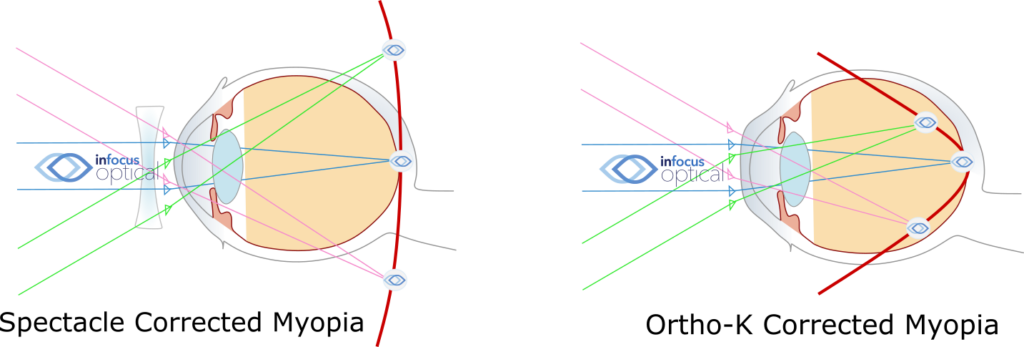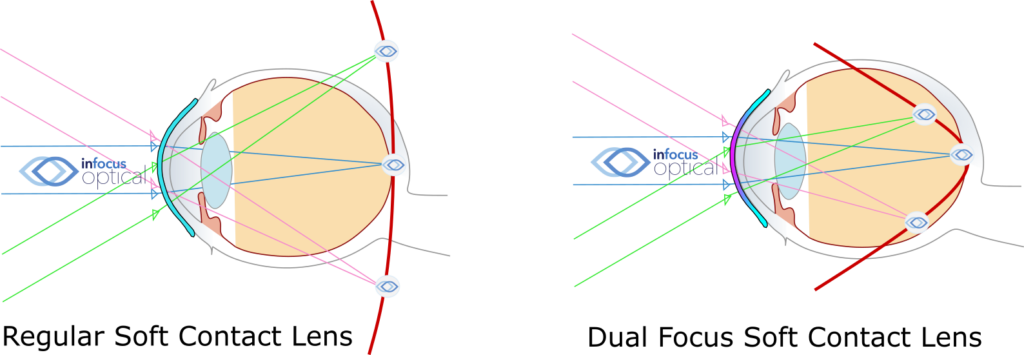What Is Myopia Control?
To begin, Myopia Control is one of the most important areas of current research. Myopia is a common eye condition where distant objects are not seen clearly. It is also known as being near or short-sighted. Today, myopia is becoming more prevalent in younger children.
Optometrists with an interest in myopia control are tackling this growing problem. Myopia control aims to stop, or slow down, progression of myopia.
Why Does Myopia Progress?
A common question is why does myopia get worse? Or even simply why is my child short-sighted?
We know there are a number of reasons that increase the chance of becoming short-sighted. Currently we know:
- Increasing use of screen-based devices (mobile phones, tablets) contributes to myopia progression
- Decrease in time spent outdoors makes myopia worse
- Genetically with one short-sighted parent, myopia risk increases by three times. Moreover, two short-sighted parents mean a six fold increase in myopia risk
- The younger and earlier myopia begins in a child the higher the risk of progression
At InFocus Optical, our optometrists are passionate about myopia. We are happy to discuss any questions and concerns about your child’s myopia. We can make a plan to help stop, or slow, worsening myopia. Our myopia control treatments aim to reduce lifelong risk of eye disease and glasses dependency.
Why Is Myopia Control Important?
You may be wondering why should I be concerned about myopia? Or even why bother with myopia control? Globally, we are seeing a trend that myopia is increasing. In Australian school kids, the Sydney Myopia Study found the prevalence of myopia has doubled to 31%. This was compared to data from a decade earlier with half the rate. In the USA, myopia prevalence increased from 25% to 42% of the population over the last few decades. More alarmingly, in East Asian countries, the prevalence of myopia has increased to 80 – 90% of the population.
In myopia, the eye ball grows too long during childhood. As the eye stretches more and more, the risk of certain eye diseases increase.
Retinal Detachment – The retina is a very thin film of receptors inside the eye. In high myopia, the risk of a detachment increases greatly. Retinal detachment requires eye surgery urgently and can lead to blindness.
Macula Damage – The macula is responsible for all your fine vision. Myopic stretching damages the macula in a way that leads to permanently reduced vision.
Glaucoma – Glaucoma is damage to the eye’s nerves leading to vision loss and blindness. Being short-sighted increases the risk of glaucoma by over four times.
Cataracts – When the lens inside the eye becomes cloudy, a cataract is forming. Cataracts tend to develop earlier in short-sighted eyes.
Additionally, progressive myopia results in thicker, heavier and costlier glasses!
What Myopia Control Options Are Available?
There are four options currently shown to reduce the worsening of myopia. Myopia control begins with a thorough vision and eye assessment. Firstly, it will involve careful consideration of age, eyesight changes and risk factors. From all this, our myopia control optometrist will advise which options may be best for your child.
Orthokeratology / Ortho-K
Orthokeratology is the use of custom gas-permeable contact lenses while sleeping. The lens gently reshapes the surface of the eye. This form of vision correction is like wearing braces for the eyes. The result is that your child can freely participate in sports, such as swimming, while free from glasses and contact lenses during the day.
Our optometrist uses advanced corneal topography equipment to precisely map the eye shape. From this we individually custom design a lens for each eye.
Currently, Ortho-K is the most effective form of myopia control.
Soft Multifocal Contact Lenses
Specially designed soft contact lenses can also slow myopia progression. These lenses differ from standard disposable contact lenses by using different optical zones. By combining vision and treatment zones, these lenses control eye growth while allowing clear sight.
Atropine Eye Drops
The main reason thought to cause myopia progression is near work and screen time. In particular, over working the near focusing of the eye leads to the eye adapting by growing longer. Atropine eye drops paralyse the near focus of the eye. As a result, we stop this driver for myopia progression. However, atropine also causes pupil dilation. This stops the ability of the eye to block and control the amount of light. By using a low dose of atropine, we aim to partially paralyse the eye’s near focus with minimal effect on pupil dilation.
As atropine does not correct myopia, glasses will still be required.
Atropine may cause slight blurry vision and light sensitivity. Some children may be sensitive to atropine.
Multifocal Glasses
Multifocal glasses have part of the lenses correcting for near vision. By using this near portion, the eye’s focusing relaxes for concentrated close up work. By not allowing the near focusing system to over work, we attempt to reduce the eye’s desire to grow longer (more myopic).
Multifocals alone are less effective. Multifocal glasses are often combined with atropine eye drops as part of a myopia management plan.
MiyoSmart Myopia Control Glasses
The latest technology in myopia control glasses, uses Defocus Incorporated Multiple Segments (DIMS) lenses. This myopia management option uses special glasses with hundreds of defocus zones on the lens surface. It enables clear vision and defocus at the same time.
The clinical research behind this special lens shows on average 60% reduction in myopia progression.
How Does Myopia Control Work?
Currently we believe the peripheral vision drives the increase in myopia. Because of complex optics, with standard correction options there is a level of ‘hyperopic defocus’ for the peripheral retina. Orthokeratology (Ortho-K) and dual-focus soft contact lenses solves this problem. Specifically, by correcting the central vision and peripheral vision separately, the ‘hyperopic defocus’ is eliminated.

These diagrams exaggerate the level of peripheral defocus to show the idea of myopia control.

The other driver of myopia progression is excessive near work. Atropine eye drops work by paralyzing the near focus eye muscles. Accordingly, this reduces the near focus demand on the eye.

Multifocal glasses also reduce the near focus demand on the eye.
Don't hesitate, visit our optometrist to discuss more on myopia control.
